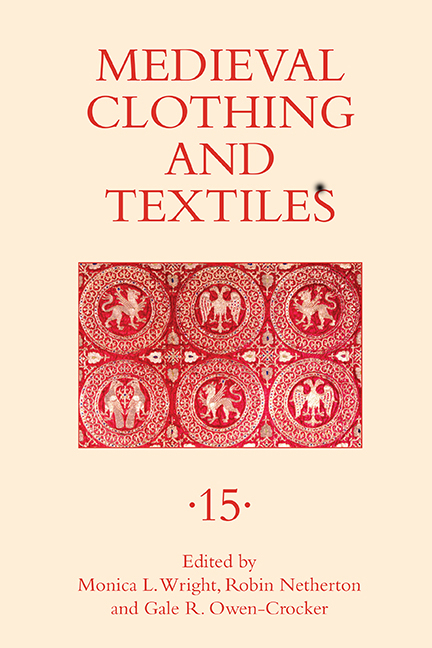Book contents
- Frontmatter
- Contents
- Illustrations
- Tables
- Contributors
- Preface
- 1 Old Rags, New Responses: Medieval Dress and Textiles
- 2 Text/Textile: “Wordweaving” in the Literatures of Anglo-Saxon England
- 3 Unfolding Identities: The Intertextual Roles of Clothing in the Nibelungenlied and Völsunga Saga
- 4 Clothing and Textiles at the Court of King John of England, 1199–1216
- 5 Dressing the Sacred: Medallion Silks and Their Use in Western Medieval Europe
- 6 Habit Envy: Extra-Religious Groups, Attire, and the Search for Legitimation Outside the Institutionalised Religious Orders
- 7 The Loom, the Lady, and Her Family Chapels: Weaving Identity in Late Medieval Art
- Recent Books of Interest
- Contents of Previous Volumes
6 - Habit Envy: Extra-Religious Groups, Attire, and the Search for Legitimation Outside the Institutionalised Religious Orders
Published online by Cambridge University Press: 31 March 2021
- Frontmatter
- Contents
- Illustrations
- Tables
- Contributors
- Preface
- 1 Old Rags, New Responses: Medieval Dress and Textiles
- 2 Text/Textile: “Wordweaving” in the Literatures of Anglo-Saxon England
- 3 Unfolding Identities: The Intertextual Roles of Clothing in the Nibelungenlied and Völsunga Saga
- 4 Clothing and Textiles at the Court of King John of England, 1199–1216
- 5 Dressing the Sacred: Medallion Silks and Their Use in Western Medieval Europe
- 6 Habit Envy: Extra-Religious Groups, Attire, and the Search for Legitimation Outside the Institutionalised Religious Orders
- 7 The Loom, the Lady, and Her Family Chapels: Weaving Identity in Late Medieval Art
- Recent Books of Interest
- Contents of Previous Volumes
Summary
On February 21, 1241, Pope Gregory IX sent a bull to archbishops and bishops alerting them to
… some women who wander in your cities and dioceses, they falsely pretend to be from the Order of San Damiano, and in order that others may comply, with the false faith of unfounded trust, to what they assert, they go barefooted, wearing the habit and the belt or the thin ropes (cordulas) of the nuns of this order, whom some call discalciatas or cordularias or minoretas … .
The purpose of this letter was to deal with groups of women who apparently had taken to dressing up in a similar way to the nuns of the Order of San Damiano, founded by Clare of Assisi some decades earlier. The bull thus instructed the ecclesiastical authority that these women had to give up their belts, ropes, and habits. The complaint of scandal from the Franciscans and the nuns of San Damiano about these women not only drew attention to the fact that these women were “fooling the trustful pious” with their attire, but also that, with the Damianites being strictly cloistered nuns, the religio simulata of these wandering women reflected poorly on the virtuous disciples of St. Clare, who did observe the norms of claustration.
Yet, as Herbert Grundmann has asserted, there was more to the conflict. These women seemed to have a genuine desire to enter the Order of San Damiano, but had not found a way to do so since, at least between 1228 and 1245, the order was neither accepting new members nor building new convents to accommodate this demand. Therefore, these women might have been more than just impostors, wandering around the cities and trying to trick the devout by appearing to be Damianites. Perhaps they were yet another group representing the wider movement of lay piety that had started to materialise throughout Europe by the end of the twelfth century and which expanded especially among women during the thirteenth century. Nevertheless, despite the possibility that their actions were indeed founded on pious intentions, Innocent IV repeated the tone of Gregory IX's bull, twice in 1250, and again in 1252, with harsh words for these mulieres who went around in a habit similar to the one of the Order of San Damiano.
- Type
- Chapter
- Information
- Medieval Clothing and Textiles 15 , pp. 137 - 156Publisher: Boydell & BrewerPrint publication year: 2019



